Black & White Updated Preview--Part One
In this hands-on preview, we talk about the game's control, quest system, and story.
Black & White--Day Two: Hands-On, Part One

As has been made public before, the game places you in the shoes of a god who resides over Eden, a land of innocence. You're given a creature that will gradually but assuredly become the physical manifestation of your presence on Eden. His demeanor and outward appearance are directly affected by the actions you perform in front of him: Smack your creature around and be heavy-handed with the villagers, and the creature--as well as the entire world of Eden--will slowly twist into a dark mirror of its former self. If you're tolerant with your creature and kind toward the inhabitants of the surrounding land, your creature will grow benevolent and caring. But this is all common knowledge, and while it's impressive on paper, we were curious to see how it translated in practice. With that, we quickly dove into our build of Black & White and tuned out everything around us.
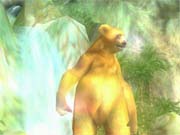
When you start the game, you're prompted to give yourself a name and choose from a number of arcane symbols to represent your kingdom--one of these symbols is none other than the Lionhead Studios logo. Once you've made your selections, the game reveals a picturesque scene of a small family standing on a beach. The husband and wife are clearly in love, and their only child is only too happy to frolic along the sand. Suddenly, and for no apparent reason, the young boy makes a run toward the water's edge, and soon after diving into the ocean, he finds himself surrounded by a pair of sharks. Horrified, his parents begin to plead to the heavens for help. Their prayers bring you to life, and the scene that follows is reminiscent of what the big bang that sparked the birth of the universe might have looked like. A white light among the stars and galaxies begins to shine brighter and glow faster. Like a comet, the light streaks past solar systems and nebulae toward the planet of Eden and the helpless boy. The light comes to a sudden stop over the boy's flailing body, transforms into a hand, and plucks him from the water and drops him off in the safety of his parents' embrace. They look up at you in thanks and then realize that they were witnesses to the birth of a god.
This is Your Conscience Speaking
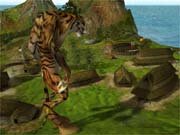
Upon saving the child, you'll be greeted by your conscience, which is represented by two classic cartoonlike figures. One of these is your evil conscience, and the other is your good conscience. In practice, these two beings are nothing more than tutors designed to guide you through the unfamiliar world of Eden. Initially, they'll both offer lots of advice on the course of action that you should take. Obviously, the devil-like conscience will always suggest that you take the easy route while your good conscience, which looks like old man time, will constantly insist that you take the high road whenever you're presented with a moral dilemma. The first thing they'll instruct you on is movement around Eden.
Black & White's control interface is unlike any other strategy or role-playing game. You control the game with a mouse, and you move by dragging your mouse pointer across the land, clicking and holding the left mouse button (the movement key), and then pulling in the opposite direction that you wish to travel. In effect, you drag yourself across the land: It's similar to scrolling up or down a .pdf document. When you move your mouse to the left or right edge of the screen, the pointer will change slightly to indicate a different type of movement option. Now, when you press the movement key and drag your mouse to the left or right, the screen will rotate in 360 degrees. Move the mouse to the upper or lower edge of the screen, hold down the move button, and you'll be able to pan your camera angle straight up and down. If you press and hold down both mouse buttons at once, your mouse movement will zoom the screen in and out. This simple feature actually showcases one of the most impressive aspects of Black & White. The game's robust 3D engine lets you zoom in close enough to clearly make out a wriggling worm in a rotten apple core and then lets you seamlessly zoom all the way out until the entire island that you oversee becomes almost indiscernible.
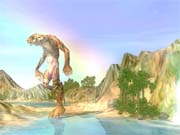
Once you become familiar with your environment, your conscience directs your attention to a temple being constructed in the middle of the villagers' town. As you'll come to find out later on in the game, this temple is the heart of Black & White. It's from here that your villagers will pray to you, which increases your power, area of influence, and the number of spells and miracles available to you. The temple also acts as your menu when you enter it. The floor of the temple is crafted from marble and is a re-creation of the world outside. In effect it acts like a map, which is surrounded by a series of doors, each of which leads to a room that lets you access numerous statistics, options, open quests, saved games, and so on. The temple is nearly complete when you come across it, and your opposing consciences suggest you help the villagers complete it. A little ways away, you'll spot the village storage facility, which houses grain and wood. It's here that Black & White's open-ended gameplay starts to become evident. Either you can pick up the wood directly from the storage shed and drop it off at the temple yourself, or you can inspire some of the villagers to become builders by picking them up and placing them near the shed. There are a number of occupations, including fisherman, builder, and breeder, that your villagers can engage in, and once they become expert in a certain field, they'll continue to do that specific task until they die.
Quests
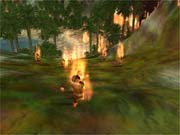
As soon as construction on the temple is complete, your consciences return and point out a floating golden scroll above the town. Black & White is literally filled with hundreds of these golden scrolls, as they generate all of the game's quests. Clicking one of these scrolls will open a short cinematic--rendered using the in-game engine and stylized with a letterbox camera view--that explains your quest and, usually, the reward you'll receive by completing that task. The first such quest involves a series of steps you'll have to take before you'll be able to receive your first creature. When you activate this quest, you'll meet a villager called Sable, who's the creatures' trainer. She tells you that there are three creatures located behind a pair of massive wooden gates. To open these gates, you'll have to collect three large gate stones--boulders--that are fashioned after different animals. The first gate stone is relatively easy to find: It's located in the center of the village and is the same boulder that the villagers danced around to rejoice your arrival. Once you retrieve that gate stone, Sable points out another golden scroll and tells you to activate it in order to get the second stone.
The quest to retrieve the second gate stone is the first test of your alignment. When you activate this quest, you'll hear the prayer of a scared woman. She'll tell you that her sick brother, in a fevered haze, ventured out into the forest hours ago. She begs of you to return her brother unharmed, and in exchange, she'll let you have the second gate stone, which is located in her house. This is a relatively small quest in terms of its size and scope, and yet, this one alone has 22 different possible outcomes, depending on what course of action you take. You can do the honorable thing and actively search for her brother in the forest and guide him back to his sister's house. She'll give you the gate stone, as promised. Or, if you're a little more devious, you can just tear her house apart and take the stone from her, saving you the time and effort. You can go so far as to kill her brother, return his corpse to the sister, and watch her die of grief. No matter how you choose to act out this quest, you'll get the stone. But how you behave starting with this quest will slowly determine how your land, temple, and later, your creature, will look.
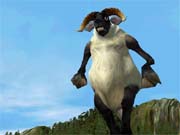
Once you retrieve the second gate stone, Sable tells you that the third stone has been long destroyed and that the town sculptor would gladly carve out a new one for you. Activate another golden scroll, and the sculptor will tell you exactly what kind of boulder he'll need to make the third gate stone. Finding the exact boulder is relatively easy, and once you bring it back to him, you'll have your third and final gate stone. With these three stones, Sable will open the large wooden gates that house the three creatures: the docile cow, the neutral ape, and the aggressive tiger.
Other Details
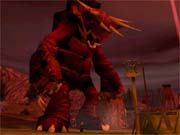
Golden scrolls aren't the only quest generators you'll find in Black & White. The game is littered with an equal number of silver scrolls, which might not initially seem as important as their golden counterparts. Unlike golden scrolls, activating and completing silver scrolls won't progress the game's story forward, but they do yield important rewards like "one-shot miracles." These are typically high-level spells that will be available for you to cast once, without having to earn them by prayer. As with regular spells, if your creature watches you cast a one-shot miracle on a regular basis, he'll eventually learn that spell and have it at his disposal at any time. You can go through the entire game, completing golden scroll quests, without ever activating a single silver scroll. However, in addition to granting you temporary spells, some silver scroll quests will prove useful later on in the game. One of the very first silver scroll quests you'll come across in Black & White, for example, is to help a group of three sailors complete the construction of their arc. You'll come across these three jolly, though slightly annoying, characters shortly after you pick out a creature. They'll tell you that they ran out of wood and need more lumber to complete work on their ship. Just like in the quest that involved finding the girl's lost brother in the woods, you're completely free to solve this quest any way you like. Being the good Samaritans that we are, we opted to help out the three beached sailors.
After you bring them enough wood, they'll ask for grain. If you get them the required grain, they'll ask for meat. Finally, if you give them some livestock, they'll thank you and sail away. Before they do, however, they'll give you a one-shot water miracle that'll give you the ability to cast a shower of rain on any location on the map. Of course, casting rain on farmland will help those crops grow and increase the rate of grain production for your villagers. But in addition to getting that water spell, if you help the sailors out, they'll actually return at a later point in the game and help you complete an otherwise difficult quest.
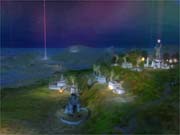
The game's 400-plus quests are divided across five unique lands, and aside from the distinct break from one land to the next, there's no real distinction between where one quest ends and where another one begins. This isn't Populous--the entire world of Black & White is persistent and constantly changing. There aren't any level transitions or missions or anything concrete of the sort. All five lands are islands, and each one is larger than the next. It'll take you about an hour or so to complete the set of quests in the first land, which really only acts as an extensive tutorial. At the end of that land's series of events, you'll meet a second, fully grown creature that will teach your own creature how to fight. This mature animal will also tell you of its master, a god called Nemesis. It'll also speak vaguely of an object called the Creed, which is split into three parts, all of which are necessary to defeat Nemesis. Enraged that his creature is giving away such ancient secrets to you--an infant among the gods--Nemesis strikes down his creature in bolts of searing lightning.
Soon after, a vortex opens up, and you're transported to the second land, where you'll meet two other gods: Kahzar and Lethys. But we're getting ahead of ourselves. We'll have much more on our impressions of Black & White tomorrow and throughout the rest of the week. Be sure to check back for additional information on this truly unique game.
Got a news tip or want to contact us directly? Email news@gamespot.com
Join the conversation